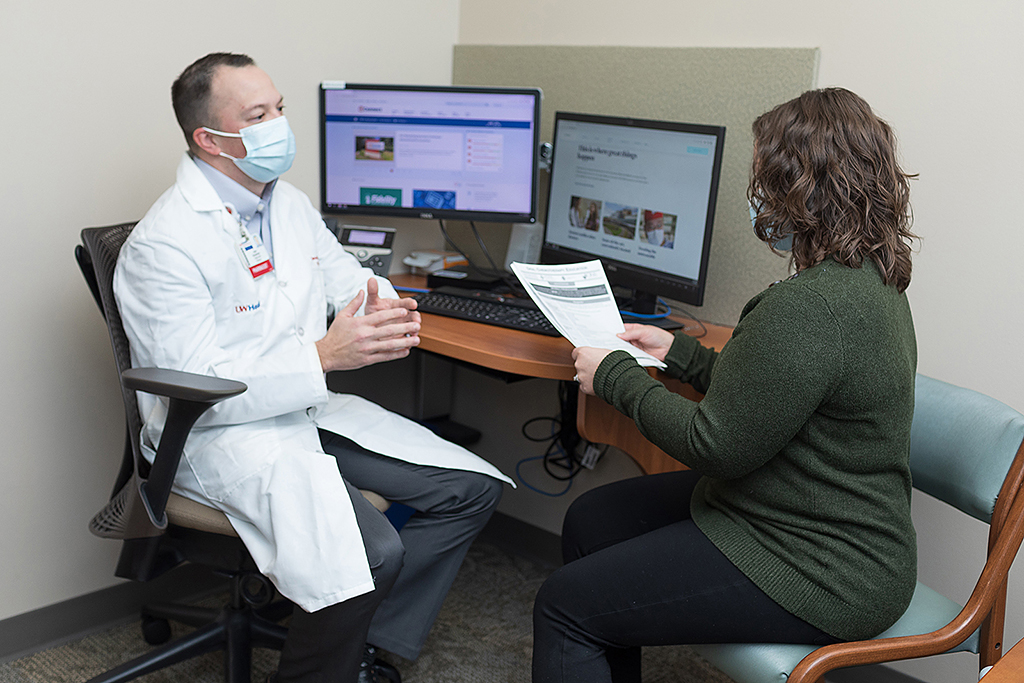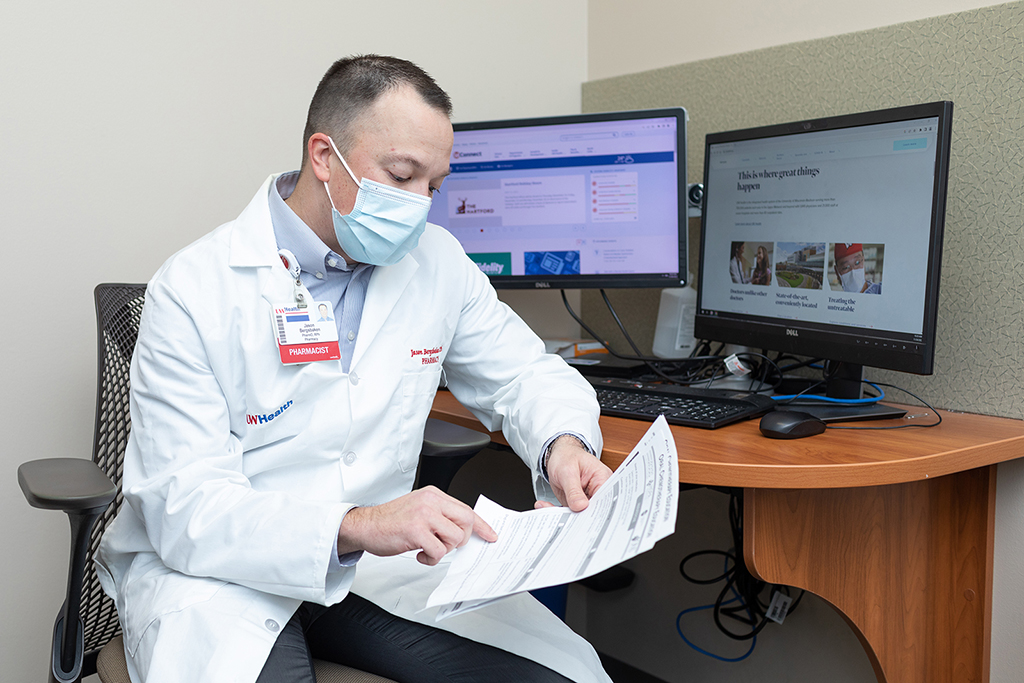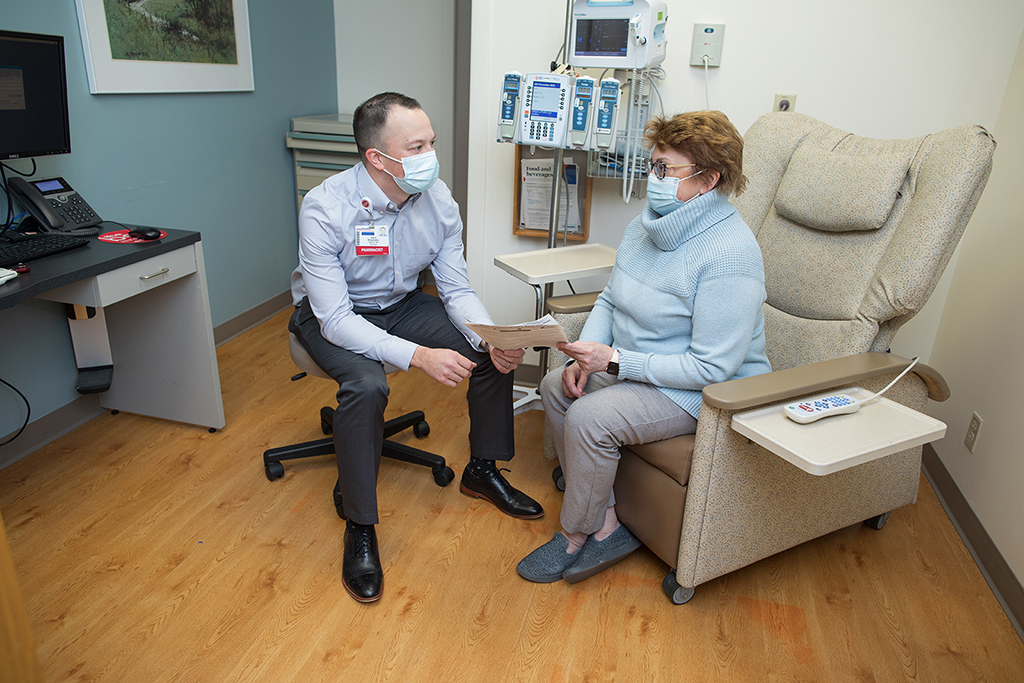Through his involvement in several pharmacist-led initiatives at UW Health, oncology pharmacist Jason Bergsbaken is working to improve cancer care
By Brianna Foth
Despite the many strides made in research and treatments over the last few decades, cancer remains one of the most prevalent conditions in the world. In the U.S., the average risk for developing any cancer is about 40 percent, leading to more than 1.7 million patients with newly diagnosed cancer each year. And those patients are reeling with questions.
As the field of pharmacy evolves to meet changing needs in healthcare, one class of pharmacy specialists rises up to meet the particular needs of these patients: oncology pharmacists, whose specialized knowledge and training allow them to work directly with cancer patients in roles ranging from medication experts to liaisons between patients and their broader care teams.
“Cancer patients are often at a unique and very challenging point in their lives,” says Jason Bergsbaken (PharmD ‘12), pharmacy coordinator for Regional Oncology Services and program director for the PGY2 Oncology Pharmacy Residency Program at UW Health. “As pharmacists, we have a lot of opportunity to help them achieve the best possible outcomes.”
“We help them along their care journey, and it’s certainly rewarding to help them achieve their desired goal or outcome, whether it’s to live longer or to have a better quality of life.”
—Jason Bergsbaken
Although oncology pharmacists can apply their expertise to a variety of roles, they are especially well-equipped to help patients select cancer treatments, respond to safety concerns, and manage their side effects.
“Oncology pharmacists see patients in a variety of settings and specialties,” says Bergsbaken, who is also a clinical assistant professor at the University of Wisconsin–Madison School of Pharmacy. “We help them along their care journey, and it’s certainly rewarding to help them achieve their desired goal or outcome, whether it’s to live longer or to have a better quality of life. I think they really appreciate us for that and are very invested in their own care.”
Selecting treatments
As a board-certified oncology pharmacist, Bergsbaken’s role at UW Health involves both working in direct patient care and overseeing broader programs that support patients and providers. Part of that work involves serving on the oncology pharmacy and therapeutics (P&T) subcommittee that selects and evaluates all oncology-related medications and regimens used within the UW Health system.
One of the biggest benefits of having been trained as a pharmacist, he says, is how well it has prepared him to adapt to the rapidly changing treatment landscape in his field.
“The standard of care for many different cancers has really evolved since I graduated from pharmacy school 10-plus years ago,” says Bergsbaken. “Through my pharmacy training that has empowered me to stay updated and relevant with new research, we’re helping patients live longer and with more quality of life.”
One way Bergsbaken has demonstrated that adaptability is through being involved with the UW Carbone Cancer Center’s Precision Medicine Molecular Tumor Board, a statewide service that leverages a multidisciplinary team of clinicians, pathologists, and scientists to review the genomic profiles of individual cancer cases in order to provide highly individualized treatment recommendations.

“In oncology, we’re learning more and more about how specific cancers behave and how their unique molecular profiles may drive select patients’ cancers,” he says. “So, more and more, we’re making individualized medication recommendations based on the patient’s molecular profiling.”
Bergsbaken is one of two pharmacists currently participating on the board, alongside Michael Fallon, a clinical pharmacist at UW Health. But pharmacists have also played an important role in the board’s foundation and leadership: Jill Kolesar, then a professor in the school’s Pharmacy Practice and Translational Research Division, and now a professor at the University of Kentucky College of Pharmacy, was a founding co-director of the board.
“Oncology pharmacists have extensive knowledge about cancer medications, with the ability to select the most appropriate therapy for a given patient based on both mutation profile and clinical characteristics,” says Kolesar. “Our specialty pharmacist colleagues are also essential in obtaining these medications for off-label.”
“We’ve tried to continue to maintain a consistent pharmacist presence on the board, because as pharmacists, we bring a unique skillset and perspective that assist with these recommendations,” says Bergsbaken.
Monitoring safety
As medication experts, oncology pharmacists have a particularly important role in managing and preventing problems related to the high-cost — and often highly toxic — drugs that are administered during cancer treatment. They can identify problems with the way the drugs interact with other medications the patients are taking, adjust dosing depending on changes in weight and lab values, and manage harmful side effects that can put patients at risk.
“Patient safety will always be our true north,” says Bergsbaken. “That’s something we have ingrained in our training, and that we always want to prioritize when taking care of our patients.”
During his residency at UW Health, in 2014, Bergsbaken worked with a multidisciplinary team of colleagues, including Mary Mably, oncology pharmacy manager, and Jessica Fischer (MS ‘08), then-pharmacy manager, to review and redesign the UW Carbone Cancer Center’s processes for managing oral oncolytic drugs. Their goal was to improve monitoring for patients on these therapies, particularly in terms of side effects and adherence.

“Oral oncolytics present unique challenges,” says Bergsbaken. “There are adverse effects that patients may experience at home, outside of the clinic setting, that need to be monitored for, and there’s also adherence challenges. We reviewed our entire oral oncolytic management process and undertook a large gap analysis to understand where we had gaps in how we safely order and monitor these medications.”
As part of their redesign, the team implemented changes including creating an electronic definition of oral oncolytics, adopting a set of uniform drug-specific educational materials for patients and caregivers, mandating the use of comprehensive electronic order sets for chemotherapy, and standardizing documentation of changes to dosing. They also developed drug-specific adherence and toxicity forms and adopted a patient diary to create uniformity in how they monitor for safety and adherence issues.
Thanks to this effort, the institution saw increased compliance with safety checks and tracked continued pharmacist interventions including dosing, drug interactions, and monitoring. In 2016, they published their findings in the medical journal JCO Oncology Practice.
“Safety is always number one, whether it’s ordering, education, or monitoring,” says Bergsbaken.
In 2020, Bergsbaken also served as an advisor on a project led by then-oncology resident Emily Hennes (PharmD ‘17) to design a chemotherapy stewardship program for UW Health to optimize the location of chemotherapy administration, partly in an effort to reduce the number of patients inappropriately receiving chemotherapy in an inpatient setting. Other pharmacist team members included Mably, Mike Reed (BS ’90), and Jason Jared.
“Safety is always number one, whether it’s ordering, education, or monitoring.”
—Jason Bergsbaken
Under the program, all regimens are assigned a standard “site of care,” based on their ability to be safely and effectively administered in an inpatient and/or outpatient setting. Patients qualify to be given a regimen normally appropriate for the outpatient setting as an inpatient if they are determined to be at a high risk for developing complications, such as tumor lysis syndrome, a condition in which tumor cells break apart and release their contents into the bloodstream, causing a harmful increase in certain chemicals in the blood.
“This project helps support ‘chemotherapy stewardship,’” says Bergsbaken. “Fundamentally, we are trying to ensure the treatment regimens are being utilized at the appropriate time and in the appropriate treatment setting.”
Managing side effects
Perhaps the most crucial area in which oncology pharmacists can support their patients is through helping them manage and minimize their side effects during the intensive treatment process. One of Bergsbaken’s most recent projects — a pharmacist-led service implemented at the UW Carbone Cancer Research Center for which he collaborated with a team of colleagues — sought to optimize the management of one of the most common side effects caused by chemotherapy: nausea and vomiting.
“Chemotherapy-induced nausea and vomiting (CINV) is a well-known adverse effect of many oncology treatments,” says Bergsbaken.
The service they created leverages pharmacists to set up in-person or phone appointments with patients suffering from uncontrolled, refractory nausea and/or vomiting. Pharmacists conduct a baseline assessment to gather information about how often symptoms are occurring and if patients are having any trouble taking their antiemetic medications. Then, pharmacists follow up to provide additional counseling on medication adherence, optimize the dosage, or assist with other medication-related issues such as drug interactions or adverse event education.

“As pharmacists, we have the ability to reach out to patients in the home setting, and not just rely on them to call us if they’re having challenges at home,” says Bergsbaken. “We can be proactive and reach out to make sure we understand how they’re doing, so that we can intervene if necessary.”
Previously, a pharmacist who had identified that a patient was experiencing refractory chemotherapy-induced nausea would need to approach a provider to discuss therapy changes, for example, an increased dose in their antiemetic medication. But their provider may not be immediately available to discuss changes. Instead, the team created a new protocol delegating authority to ambulatory oncology pharmacists to start, discontinue, or adjust antiemetics as needed to address patients’ symptoms.
“There are guideline-based recommendations for what patients should receive to help manage their symptoms, but due to a variety of factors, those don’t work optimally for every patient,” says Bergsbaken. “So, understanding the nuances of the medications we use in nausea and vomiting management, especially in those difficult-to-treat cases, is an important role that we play as pharmacists. We have a unique perspective to be able to offer recommendations there.”
After trialing the service for a year, the team conducted a retrospective chart review, in which they found that the service had not only helped reduce the severity of nausea and vomiting for its patients but had also ensured that all enrolled patients became adherent to their medications. They published a report of their findings in the Journal of Oncology Pharmacy Practice.
“At the end, our goal was to improve CINV management, and to understand how we could leverage pharmacists to do that,” says Bergsbaken. “With our continued work in this area, we are trying to understand where we should deploy pharmacist resources to help make the biggest impact on patient outcomes. For example, we are looking to identify high-risk patient populations where additional education and additional monitoring touchpoints early in the course can help improve nausea and vomiting outcomes.”
“Through my pharmacy training that has empowered me to stay updated and relevant with new research, we’re helping patients live longer and with more quality of life.”
—Jason Bergsbaken
Patient education is another important opportunity for oncology pharmacists to help manage CINV, says alum Maggie Schenkat (PharmD ’20), oncology and hematology pharmacist at UW Health who works alongside Bergsbaken. This education starts right when patients begin their treatment.
“We see all new patients to educate them on how to recognize CINV, how to utilize their antiemetics at home for prevention and treatment, and even non-drug strategies,” says Schenkat. “We will also see patients as they progress through their treatment to assess for CINV and make recommendations on how to best manage it.”
Reflecting on his many projects to improve patient care, Bergsbaken is reminded of what drew him to oncology in the first place: the patients.
“The biggest thing that drew me to oncology was the patient population,” he says. “We have a unique ability to impact their care, when they really need it, in multiple different settings over a longer period of time, and we can really develop relationships with them, which is very rewarding.”